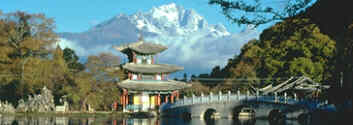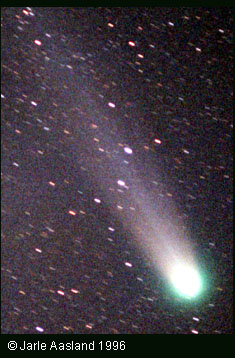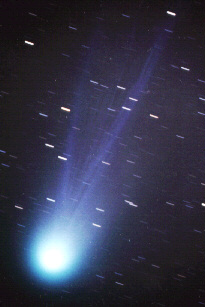
During 1996 and 1997, Kaifan Ji, an astronomer from Kunming, in Yunnan Province, China, met over an Internet Relay Chat (IRC) channel with several individuals in different parts of the world. In particular, people on the #Hope and #1hope2 channels on the Chatnet IRC network became good friends with Ji, who was, at that time, the CCD laboratory chief at the Yunnan Astronomical Observatory in Kunming, discussed the interest of his research team in using the internet as an integral part of their scientific studies.
One of Dr. Ji's colleagues in the Chinese Academy of Sciences is Professor Yi Chu, Associate Professor of Astronomy, Nanjing University, in Nanjing, China. Professor Chu was, at the time of this experiment, a Visiting Professor of Astronomy at the University of Florida, in Gainesville. His absence from China, with potential loss of his observatory time at the Yunnan Astronomy Observatory is a typical example of the kind of situation which sparked discussion of and development of this project.
The third person critical to this project is Professor Bin-Xun Ye, a world known solar physicist/astronomer at Beijing Astronomical Observatory. Professor Ye proposed the whole plan of the first intercontinental Remote Presence Observation Project, according to Professor Chu.
Over the course of discussions with Dr. Ji, several people who had become his friends on the internet, began asking questions about his work. Naturally, the experiments he and his two associates had conducted on their RPO project entered into the discussion. Their first try involved use of e:mail to keep in touch from remote locations while running astronomy observations in Kunming. They had only a very slow modem at the Kunming site. The transfer of images and e:mail conversations was useful, but the transmissions were so slow that the experiment was considered only partially successful.
With the help of friends on the IRC, Dr. Ji suggested a trial using the IRC network as the medium of communication. Messages, typed on a local computer appear within seconds on all other computers connected to the particular IRC network channel. Text files or graphic images saved on one computer can be sent over the internet to a central site to be saved and viewed on demand by any of the parties in the RPO project. To accomplish the communications it would be necessary to load appropriate software to computers at the sites where his colleagues were located, sites, and arrange for a degree of privacy for the otherwise open channel of the IRC networks.
Several of the members of the #Hope and #1hope2 Chatnet channels became very interested in this project, recognizing that it was a historic breakthrough for their astronomer friends. Some of them with expertise with the software required to accomplish the project, were very helpful to staff working at the remote sites in Beijing, and Gainesville. Each had a hand in one aspect or another of assuring that the remote sites would have ready access to the IRC communications. The chief operator of the Chatnet server in Pocatello Idaho agreed to provide space on his FTP server for the images from the Kunming telescope to be stored, and made accessible to all the participants. The Chatnet channel masters also agreed to allow temporary use of a Channel to be named #RPO for the duration of the experiment.
As a test, on Tuesday, March 4, Dr. Ji uploaded four pictures of comets, some he had received from other astronomer friends during an evening IRC session, but some of these were taken by Dr Ji and one of his associates. [See their report in the NASA Hale-Bopp Comet Archives ] The project's real online test occurred in the early morning hours of March 6, when the live uploads were done. This time, the project was an unqualified success. The three astronomers, one in Kunming, another in Beijing, and the third in Gainesville, Florida were able to discuss the images as each one was placed on the ftp server, and decide the successive actions to take.
 Here are the five test pictures of comets that were uploaded Tuesday, March 4. This was the first fully successful cooperative China-North America astronomical link, done on an ad-hoc basis, friend to friend, over the internet! Enjoy these
five pictures in JPEG(.jpg) format of these observations!
Here are the five test pictures of comets that were uploaded Tuesday, March 4. This was the first fully successful cooperative China-North America astronomical link, done on an ad-hoc basis, friend to friend, over the internet! Enjoy these
five pictures in JPEG(.jpg) format of these observations!




These successful tests gave the astronomers confidence that their live image project would work as planned. Accordingly, two days later, they conducted the actual experiment, transmitting live images and discussing various adjustments to the telescope and their instruments over Chatnet IRC links during the time they had scheduled use of the one-meter telescope in Kunming.
Adrian Jupe was one of those who assisted, via IRC and e:mail in getting the appropriate software set up on the remote site computers. His expertise, as one who works daily at an internet provider in the UK, was invaluable. In addition, Jupe provided space on his server as long as he continued working there, for the Official RPO Project Homepage. [This website is currently considered to be the "Official" site.]
Vincent Wardhaugh is one of the others who helped set up the IRC on the remote sites, sharing his expertise as a software specialist. He also has the RPO project highlighted on his homepage.
Georgia Philbrick is the person centrally responsible for the basic arrangements that allowed this historic project to come to fruition. She is a nurse, with an internet habit, who made the friends, arranged for them to discuss their needs, and sought out the necessary resources to move the project from a great idea to a real accomplishment. Kayj, as she is known on the IRC chat networks, also has a homepage which , features this historic project.
There were several other key players at various sites, and without their efforts in support of various aspects of the project, it would not have been successful. In Kunming China, at the Yunnan Astronomical Observatory, we must recognize the contributions of the team working with Dr. Ji, consisting of Dr. Qian Song, Dr. Wenda Cao, Dr. Qingyu Peng, and Mr. Veivei Liu. In Gainesville, at the University of Florida, Dr. Kwan-Yu Chen, Professor of Astronomy has been very supportive of Professor Chu. While making arrangements for the computer hookups in Florida, Mr. Jun Sun from the UF Department of Electrical and Computer Engineering conferred with Wardhaugh and others.
As with any other major project, there are many persons to thanks are due, so we extend appreciation also to the whole of the RPO team, for making it a full success. As a token of their appreciation for the help of some of us in the IRC Chatnet, the astronomers sent some beautiful images, modified as internet thank-you notes addressed to various members of the team. These additional images are worth your time to peek at.
Go back to the top of this document, OR
return to the RPO index page